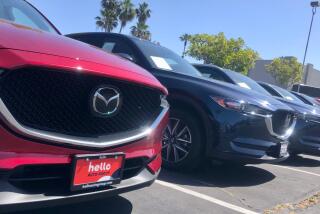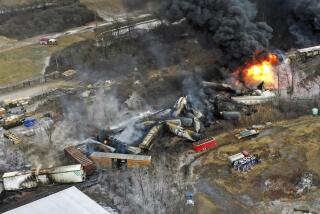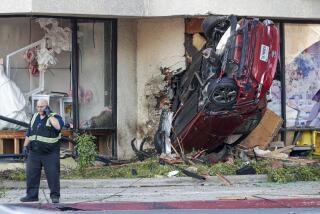Toyota is just the latest automaker to face auto safety litigation
On a summer day in 1911, Donald MacPherson was driving his Buick runabout to Sarasota Springs, N.Y., when the wooden spokes snapped on a rear wheel, flipping the open car and trapping him under the rear axle.
MacPherson suffered a badly lacerated eye and a broken wrist so painful he couldn’t grip the tools he needed to ply his craft as a stone cutter. He sued Buick Motor Co., alleging negligence in failing to ensure the wheel was roadworthy.
In what would become a landmark ruling in product liability law, the New York Court of Appeals in 1916 awarded MacPherson $5,025 in compensation -- about $115,000 in today’s dollars -- and established the automaker’s “duty of care” to ensure customers are sold a safe product.
A century later, litigation continues to be a significant factor in making the automobile safer, say legal and auto industry experts. Consumers, insurers, federal regulators and automakers themselves also play big roles, but lawsuits are credited with such innovations as impact-absorbing dashboards and steering columns, and gas tanks that won’t explode when a car is rear-ended.
“One instance where litigation did obviously play a role was with the gas tank placement issue, and [Ford’s] Pinto was only one example,” said Logan Robinson, a University of Detroit law professor and former general counsel for Chrysler International, recalling the 1970s rash of small cars exploding after rear-end collisions. “Now, most all cars are designed to take at least a 50-mph hit.”
Toyota Motor Corp. is now facing an avalanche of lawsuits stemming from its problems with sudden acceleration and braking, which have triggered about 10 million recall notices worldwide. In Toyota’s case, however, the recalls have occurred on such a grand scale that safety improvements may be dictated by federal regulators and lawmakers, not by class-action attorneys.
Legal historians say that, aside from the MacPherson case, almost all of the litigation that led to significant safety improvements occurred in the last half-century.
In the watershed 1968 ruling in Larsen vs. General Motors Corp., the U.S. 8th Circuit Court of Appeals held the carmaker liable for injuries suffered by the driver of a 1963 Corvair when a collision drove his head into the steering column.
The ruling overturned decades of legal convention in requiring automakers to address design features that could inflict injury as a result of a crash, even if the defect didn’t cause the accident.
“The courts then became a much more active place for plaintiffs and their attorneys to come with claims of injury caused by insufficient crash-worthiness design,” said Ben Kelley, a former Transportation Department official and pioneer in vehicle safety research for the Insurance Institute for Highway Safety.
In the 1970s and ‘80s, litigation was watched keenly by manufacturers and regulators as a kind of early warning system on safety defects, said Kelley, now semi-retired and consulting on auto product hazards from his home in Pebble Beach, Calif.
Steered by lawsuits and safety standards set by the National Highway Traffic Safety Administration after its creation in the late 1960s, automakers corrected design defects that had exposed drivers to impalement on gearshifts and lacerations from shattered auto glass.
Also in the 1960s, seat belts became widely adopted by automakers and crash tests were refined into a serious science.
The 1970s provided automakers with a wake-up call in the Grimshaw vs. Ford Motor Co. case, in which a California appeals court ordered the carmaker to pay $125 million in punitive damages to the victims of one of the Ford Pinto’s fiery explosions. The huge punitive damages award followed evidence showing that Ford knew of the defect but failed to recall the vehicles for what was estimated to be an $11 repair. The award was reduced to $3.5 million in a post-verdict negotiation but nevertheless was one that signaled to the auto industry that it would be harshly sanctioned for ignoring known defects.
Improved seat belts and seat backs emerged in the 1980s, spurred by lawsuits brought on behalf of accident victims. Before three-point restraints were made mandatory a decade ago, back-seat occupants were prone to paralyzing injury when frontal crashes caused their upper bodies to fly toward the impact, smashing into seats, doors or other passengers.
Advances in seat-belt safety have been gradual, notes Milwaukee lawyer and engineer Donald H. Slavik, who has spent most of his career litigating auto design defects. Lap belts were mandatory from the early 1960s, but it wasn’t until the 2007 model year that NHTSA required shoulder restraints for all seats of a car.
Stronger seats and mounts came about during the 1980s and ‘90s, in part because of lawsuits brought over flimsy seat backs that collapsed on impact or flew out of the tailgatesof station wagons, trucks and vans, said Raymond Paul Johnson of El Segundo, who has been litigating auto product liability cases for 30 years.
The soaring popularity of sport utility vehicles over the last 15 years has brought a variety of new safety hazards, industry observers note, such as removable seats that can become missiles upon impact if not correctly stowed.
In 2000, lawsuits filed in some of the 100-plus deaths from Ford Explorer rollovers helped force the automaker to recall the SUVs and replace the Firestone tires with which they had been equipped. The tires were found to be prone to tread separation and failure, and the Explorer was more than twice as likely as other SUV models to flip when a tire failed.
Ford and Firestone blamed each other during the litigation and government probes leading up to the recall, and their 100-year collaboration ended. But industry analysts note that better tires and electronic stability control -- now standard on SUVs -- emerged largely because of the Explorer’s problem.
The insurance industry and automakers have also advanced safety. Insurers, who bankroll crash testing and provide elaborate performance reports for all vehicles marketed in the country, can take credit for getting automakers to improve front-end impact resistance and the government to impose better roof-strength standards to protect occupants during rollovers.
“These are big improvements, and not just addressing defects but the way vehicles are designed to manage crash forces so that people can be better protected from injury,” said Adrian Lund, president of the Insurance Institute for Highway Safety, which was founded in 1959.
Automakers have addressed mounting consumer demand for safer vehicles with developments such as anti-lock brakes and electronic stability control, said Wade Newton, spokesman for the Alliance of Automobile Manufacturers. He points out that only about 1% of accidents now involve fatalities, and that the automakers are focused on further reducing highway deaths with accident-avoidance features such as lane-change detection.
In Toyota’s case, analysts predict that the automaker’s alleged acceleration and braking defects will lead to lifesaving modifications that give drivers the ability to override a malfunctioning electronic control system.
“For safety’s sake, it’s going to be a good thing,” said Johnson, the El Segundo auto safety litigator. “It’s going to be painful for Toyota and problematic for consumers who’ve got to bring their vehicles in, but in the end it’s going to be great for highway safety.”







